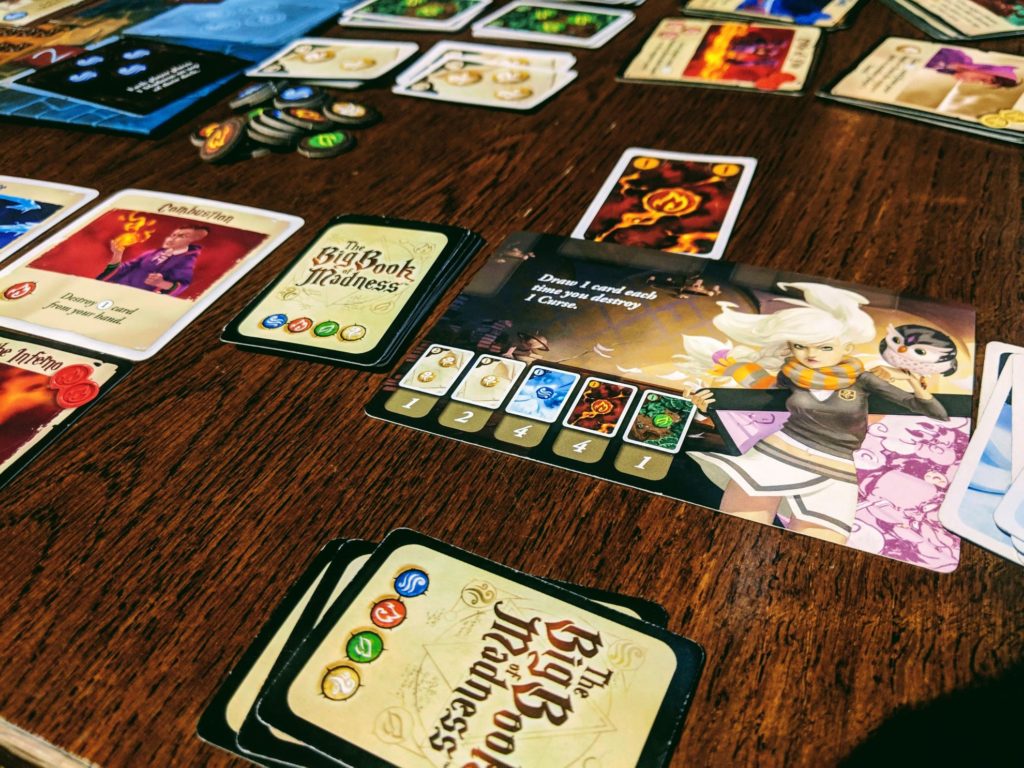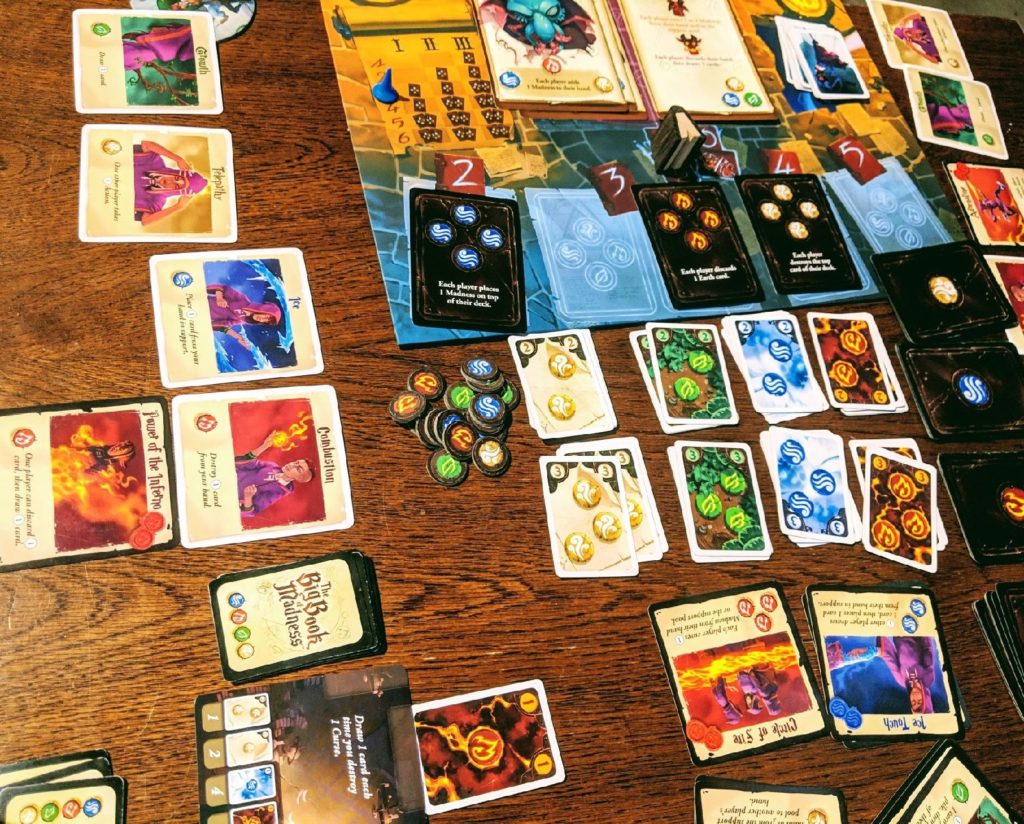“We need to take care of that multi-element curse and the fire during my turn.”
“I have 3 earth elements and 2 fires.”
“I can give you a round with my Telepathy spell so you can add the fires as support.”
“Or use your Tsunami spell and we can both add cards in support.”
“Yes! And then you can use my 3-value water card for the next curse.”
“Easy-peasy.”
The Big Book of Madness is a cooperative deck-building game by Iello, where you need to work as a group and try to finish reading an evil book before you all go mad. This premise sounds very foreboding but this couldn’t be further from the truth. Reading a malicious grimoire certainly goes better than in the Evil Dead.
The players take the roles of teenage wizards and witches who find a big dusty book in the school library and since teenagers have no self-control, they open it. Here is the catch, once you open the book you have to finish it, there is no going back. The book starts spawning monsters, and the group of students will have to learn everything they can, and go through the book canceling curses and defeating hellspawns before madness takes over their minds.

The gameplay is fairly straightforward. Each player picks a student, each has different special abilities and starting decks, and gets their starting spells which are the same for everyone. The group collectively puts together a grimoire of random monsters and decks of library spells, which are upgrades to the basic spells. The first player flips the book open and summons the first monster. Each monster card shows what kind of curses the monster will try to cast, the reward for defeating the aforementioned hellspawn, and the penalty for failing to do so. Each curse card shows what kind of elements can neutralize it and what are the consequences of letting the curse happen. These dire consequences can be driving the players insane, strengthening other curses, having players discard cards, etc. The students will have to play element cards from their decks (i.e. call on ancient elemental forces) to cancel the curses. If all the curse cards have been taken care of, then the monster is defeated. If even one curse remains on the board, the players have to suffer the penalty of letting the monster live.
Players can do several actions during their turn. They can play element cards to defeat curses, they can buy better element cards (thus upgrading their decks), and they can learn new spells. The spells are a really nice touch, since they add a couple of fun mechanisms that make the puzzle of putting together specific elements really interesting. With the four basic spells you can give another player a turn, you can destroy cards from your deck, you can put cards in support (which means others can use those during their own turn), and draw another card. Higher level spells do more complicated things, but one player can only have five active spells, so players have to figure out which spells are the most useful in their situation.
The game is called The Big Book of Madness so there has to be some sort of Madness mechanism. Curses and monster will add Madness cards to the players’ decks, diluting their carefully crafted decks. These cards are useless and if a player gets a hand of six Madness cards during a turn they go insane and are out of the game. Discarding two of the same element lets the players cure a madness card, and there are also higher level spells that can heal madness.
To win the game the players simply have to go through the grimoire, survive, and defeat the final monster.

The Good
The first thing I want to mention is the art. It is colorful, fun, bright, the monsters look unique, and the overall look and feel of the game is just beautiful. And the theme features magic, so I am sold. The spells also match their thematic elements well, e.g. fire spells usually destroy cards, earth replenishes your deck, etc.
Secondly, the game is a very fun puzzle. You see the current curses that need beating and also what the next curses will be. Each round you need to make a choice, spend the elements on canceling curses, or on better element cards and spells for future curses. You can do a lot of things, sometimes you should get rid of the curses at any cost, sometimes it might make sense to just take the curses and the penalty and prepare for the next monster instead.
The option to use spells adds a surprising number of combinations for your actions. For example, a simple spell like giving someone else an action opens up the possibility of using their spells, which will be different from the original player’s since the library spells are all unique. The complexity level is pretty well set, each round you will have a lot of options for your actions without being overwhelmed by all the possibilities. Just enough to make the puzzle intriguing.
The game also has a pretty good replay value, since the monsters and the library spells are chosen randomly for each game.
It is also worth mentioning that in deck-building games you usually have two types of cards: some sort of currency and something else, which could be attack value cards or victory point, etc. In this game they came up with a system where your hand holds four types of elements that count both as currency and attack, which is neat.
The Bad
We have only played a few games and it felt too easy. Though we did play it on easy, so maybe I shouldn’t be complaining, and the game has other difficulty settings, so this might not actually be an issue.
The biggest problem with the game is the ending. It feels a bit weird that the victory condition is to simply defeat the last monster, so theoretically you could let all the others go as long as you somehow get through the last one and still win. One thing I would change in the game is that the last monster should be more difficult and more distinguishable from the rest. Currently there isn’t really a difference between the last one and all the other monsters, but the whole point of the game is to defeat that last one, so I think the game could benefit from having a separate boss deck.
Also the difficulty of the game doesn’t really grow. The game ups the threat level of monsters by adding multi-element curses, one or two of those in later rounds, but it still feels like the game resets after each monster. You don’t get the feeling of being overrun by a horde at the end if you haven’t cleaned them up properly in earlier turns. The only lasting damage in the game is the madness, but to us it didn’t feel like too much of a threat, especially because you can simply cure a madness card by discarding two of the same element.
As mentioned above, the theme is really good and the art matches it nicely. However, the playable characters feel underdeveloped. First of all, they don’t have names. I guess we could name them ourselves, but if felt weird that I couldn’t refer to my mage by name, just by specifying her gender and elemental focus (female air mage). Also the special abilities don’t seem to match the mage’s elemental strength. For example, the water mage with the sea creatures artwork can use an air element as any other element during their turn. Wouldn’t it make more sense that they can do something special with water? When we played the game I was an air mage but I didn’t really specialize in air spells or air elements.
The Co-Op
The co-operative element works very well in the game. Being able to give another player a round and having a collective pool of cards through the support mechanism makes it a very good co-op puzzle. Players will constantly discuss options, try to prepare for future curses, and plan out their moves together. Especially in the beginning, most curses require 4 elements of the same kind and players won’t be able to gather that on their own.

It reminds me of Ghost Stories, even though the two games are very different, but it still feels similar since you have a puzzle of X number of foes (ghost or curses) that you need to defeat together using some very simple mechanics (dice vs cards) spiked with other features (village tiles vs spells).
The Recommendation
Overall this is a solid and fun game with good co-op mechanics. If you are looking for a not too long, not too complicated, fun game, and also like magic, this is the game for you.
Info
| Release Year | 2015 |
| Genre | Deck Building |
| Difficulty | Easy |
| Number of Players | 2 to 5 |
| Length | 60 - 90 minutes |
Rating
| Overall | Good |
| Story | Mediocre |
| Co-Operation | Great |